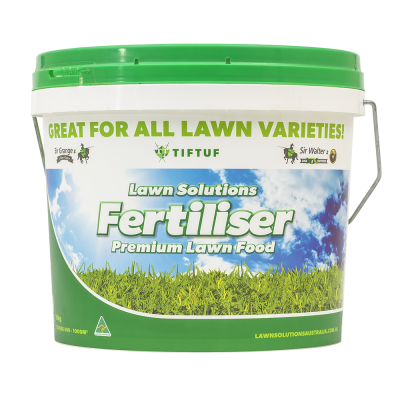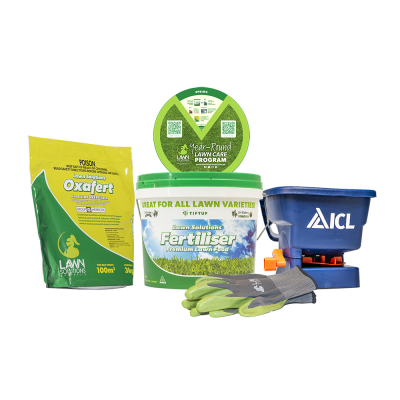Keeping a healthy and lush lawn for the most part can be achieved with a basic, regular lawn care schedule. But if you encounter any issues, it is best to know what they are so you can get a treatment plan to tackle the problem head-on. In this blog, we’ll explore three common lawn problems: brown spots, weeds, and pests, while looking at the best way to resolve any potential issues.
Skip to: How Do I Stop Weeds in My Lawn?, How Do I Stop Lawn Pests?
How can I Stop Brown Patches in My Lawn?
Brown patches can be a common lawn problem for various reasons. So, knowing why they occurred will help you find the best way to get your lawn back on track. Let’s look at a few reasons why brown spots appear:
Brown Spots from Scalping with a Lawn Mower
Scalping occurs when the mower blades cut the grass too short, removing the green leaf and exposing the runner and stem of the grass. This can lead to turf stress and create brown patches. There are two main reasons scalping can occur: the first is from your lawn growing too long in between mows, and the other is from uneven levels in the soil, causing the scalping to happen where the levels are high.
For more information on how to help stop scalping from occurring on your lawn, check out our blog here.

Brown Spots from Disease
Fungal diseases are another common lawn problem that can also be a culprit behind brown spots in lawns. Some tell-tale signs that your lawn has a fungal disease are discolouration, mushrooms, and other fungal growth.
To stop and prevent lawn diseases, ensure proper drainage, and aerate the soil. Avoid overwatering, as excess moisture creates a favourable environment for fungal growth. If the disease does persist, a fungicide may be required.

Brown Spots from Dog Urine Burn
Another common lawn problem that many dog owners may face is urine burn. The high nitrogen content in urine can burn the grass, leaving behind yellow or brown patches. One common sign that urine burn is causing patches in your lawn is that once the burn has occurred, the brown patch of grass won’t spread.
There are a few different methods you can try to help stop urine burn patches. One solution may work for one dog but not for another, so you may need to try a few different methods to find a solution for your pet. Check out our blog for more information on how to help stop urine burns here.

How Do I Stop Weeds in My Lawn?
For the most part, a healthy and thick lawn should be able to block out most weeds that can infiltrate your lawn. But if any pesky weeds have managed to grow through, let’s look at how to remove a few common weed types and how to remove them.
How to Remove Clover in My Turf
Clover is one of the most common weeds that can be found in lawns. It can be easily identified by its oval-shaped leaves that have white circular markings across all the leaves. We recommend using a broadleaf herbicide like All Purpose Weed Control, Estate Herbicide or Bin Die if you have available. Estate Herbicide 250ml Concentrate has recently been introduced to replace the recently discontinued product Bin Die Concentrate.

How Do I Remove Bindii from My Lawn?
Known for its sharp, painful seed pods, bindii can quickly become the bane of your barefoot existence. Removing Bindii, is the same as Clover, with the use of a broadleaf herbicide like All Purpose Weed Control or Estate Herbicide.

How Can I Remove Nutgrass from Growing in My Lawn?
Nutgrass is part of the sedge weed family. It gets its name from its nut like bulbs that can be found on the roots of the plant. It has thin, strappy, light green leaves that grow taller than the rest of your lawn. As nutgrass has its underground bulbs, it is best to avoid pulling it out by hand. For removal, it is best to use a selective herbicide like Sedge Control.

How Do I Remove Summer Grass from My Lawn?
Summer Grass is an annual grassy weed similar in appearance to Paspalum and Crowsfoot. As this weed spreads by its seed, you can prevent it using a pre-emergent herbicide like Oxafert. If it is already growing, it is best to either remove it by hand or use a selective herbicide with DSMA as the active, like David Greys Crab Grass and Clover Killer (not safe on Buffalo or Kikuyu lawns).

If there is another type of weed that has invaded your lawn, but you are not sure what the best way to remove it is, check out our Ultimate Weed Guide here.
How Do I Stop Lawn Pests?
Another common lawn issue you may face is lawn pests. Most insects that are in our lawns won’t damage your turf and are quite beneficial to your lawn and its natural ecosystem. But there are a few that you should keep an eye out for, as some can cause damage.
Lawn Grubs
Lawn Grubs and African Black Beetles can be a common sight in your lawn, and in small numbers, they generally won’t cause too much damage to your lawn, but if there is a large infestation and they are causing damage, an insecticide may be needed.

Armyworm
Another common lawn problem is Armyworm. Armyworms can be identified by their three prominent white or cream stripes running down the back and sides of their bodies, which can be 2mm to 40mm in length. If you do spot one Armyworm in your lawn, it is a common sign that there will be more in the lawn as they move in large numbers. If they are spotted in your lawn, it is best to act fast as they can devastate a lawn within a matter of days.

Armyworm and Lawn Grub Treatment
If you have noticed Armyworm or an infestation of Lawn Grubs in your lawn, we recommend treating your lawn with a 2-punch method.
Firstly, use a fast-acting insecticide like Battle Insecticide to get a quick knockdown of what’s currently crawling in the lawn. You may need a follow-up application after ten days to ensure you are treating the entire lifecycle.
We also recommend looking at using a preventative insecticide like Grub Guard Ultimate to help prevent another attack on your lawn for up to 6 months. When Grub Guard Ultimate is applied at six monthly intervals, it will provide seasonal protection to your lawn.
For more lawn care tips and advice, make sure you check out the Lawn Solutions Australia YouTube channel here.


